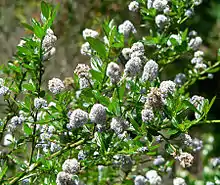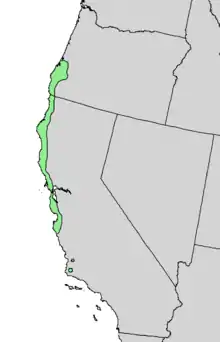Ceanothus thyrsiflorus
Ceanothus thyrsiflorus, known as blueblossom or blue blossom ceanothus, is an evergreen shrub in the genus Ceanothus that is endemic to Oregon and California. The term 'Californian lilac' is also applied to this and other varieties of ceanothus, though it is not closely related to Syringa, the true lilac.
| Ceanothus thyrsiflorus | |
|---|---|
 | |
| Scientific classification | |
| Kingdom: | Plantae |
| Clade: | Tracheophytes |
| Clade: | Angiosperms |
| Clade: | Eudicots |
| Clade: | Rosids |
| Order: | Rosales |
| Family: | Rhamnaceae |
| Genus: | Ceanothus |
| Species: | C. thyrsiflorus |
| Binomial name | |
| Ceanothus thyrsiflorus | |
 | |
| Natural range of Ceanothus thyrsiflorus | |
| Synonyms | |
| |
Description
Ceanothus thyrsiflorus can grow more than 6 m (20 ft) tall in its native chaparral habitat. Flowers vary from different shades of blue to close to white. It is popular with birds, butterflies, and other pollinators. It's often visited by honeybees for its pollen.
Cultivation
Ceanothus thyrsiflorus has been used in gardens extensively, and several cultivars have been selected. Popular garden varieties include:-
- 'Blue Mound' which can grow to 1.5 m (4 ft 11 in) tall
- 'Cascade' which may reach 8 m (26 ft) of height
- 'El Dorado', a variegated cultivar with gold edge foliage and powder blue flowers[2]
- 'Repens' which stays as a shrub around 1–3 m (3 ft 3 in–9 ft 10 in) tall
- 'Repens Victoria', forming a sturdy evergreen mound and most useful groundcover with powder blue flowers
- 'Skylark', a tall type with blue flowers (this cultivar has gained the Royal Horticultural Society's Award of Garden Merit)[3]
- 'Snow Flurry', with white flowers
Etymology
Ceanothus is derived from the Ancient Greek, keanothos (κεάνωθος; 'spiny plant'). The name was originally used by Theophrastus for another plant, and Linnaeus reused it for Ceanothus.[4]
Thyrsiflorus is derived from the Ancient Greek thyrsos (θύρσος; meaning a 'contracted panicle, wreath, or thyrsos') and the Latin florum (gen. 'flower'), and so, thyrsiflorus means approximately 'with flowers arranged in the shape of a contracted panicle or thyrsos staff'.[4]
References
- Lem. Ill. Hort. 7: t. 268 1860
- Botanica. The Illustrated AZ of over 10000 garden plants and how to cultivate them, p. 202 Könemann, 2004.
- "RHS Plant Selector - Ceanothus 'Skylark'". Retrieved 19 July 2013.
- Gledhill, David (2008). "The Names of Plants". Cambridge University Press. ISBN 9780521866453 (hardback), ISBN 9780521685535 (paperback). pp 96, 168, 379
External links
| Wikimedia Commons has media related to Ceanothus thyrsiflorus. |
- CalFlora Database: Ceanothus thyrsiflorus (blueblossom)
- Jepson eFlora (TJM2): Ceanothus thyrsiflorus
- Ceanothus thyrsiflorus — U.C. Photo gallery